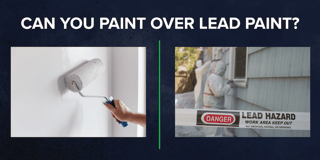
If your home or business was built before 1978, there’s a chance it may have lead-based paint. Lead paint can pose serious health risks, particularly to children and pregnant women, due to lead poisoning2. If you’ve discovered lead paint in your space, you might wonder: can you simply paint over it? The short answer is yes, but only with proper precautions and the right process.
Is Painting Over Lead Paint Safe?
Painting over lead paint, a process called lead paint encapsulation, is recognized by the U.S. Department of Housing and Urban Development1 as a method for managing lead hazards. However, it must be done correctly to ensure safety. Encapsulation seals the lead paint beneath a new, durable layer, preventing lead dust and chips from becoming airborne and posing health risks. While this method is effective, it’s not always a permanent solution, as wear and tear over time can expose the lead-based layers underneath.

Precautions Before Painting Over Lead Based Paint
Before you begin encapsulating lead paint, take these essential precautions:
-
Have a Professional Test Lead Paint: Understanding your level of risk and where lead paint resides in the home or building is important to eliminating lead exposure2.
-
Check for Paint Chips or Peeling Paint: Encapsulation only works if the lead paint is intact. If the lead based paint is showing signs of peeling or chipping, it must be removed or stabilized first.
-
Use a Lead-Safe Certified Encapsulation Paint: – Regular paint won’t effectively seal lead-based paint. Instead, use a specialized encapsulant designed to bond with lead paint and create a durable barrier. Safe encapsulants1 include: polymers with flexible membranes, epoxy or polyurethane polymers and cement-like materials with polymers.
-
Wear Respiratory Protection and Other Protective Gear: Use gloves, safety goggles or eye protection, protective clothing and a respirator rated for lead dust to avoid exposure.
-
Contain the Area: If working indoors, seal vents and doorways with plastic sheeting to prevent lead particles or lead dust from spreading.
-
Ensure Proper Ventilation: Open windows and use fans to improve airflow while working.

How to Paint Over Lead Based Paint
If the existing lead-based paint is in good condition, follow these steps for safe encapsulation:
-
Clean the Surface – Wash the area with a heavy-duty cleaner or TSP (trisodium phosphate) to remove dirt, grease, and debris before painting over lead paint. Do not sand lead paint before beginning as this could release lead dust.
-
Apply a Lead Encapsulant – Follow the manufacturer’s instructions for applying the encapsulating paint. This may require multiple coats to fully cover lead paint.
-
Allow Proper Drying Time – Ensure each layer dries completely before adding another coat.
-
Apply a Topcoat – Once the encapsulant has dried, apply a high-quality latex or oil-based paint for additional protection and aesthetics.
-
Monitor for Wear and Tear – Regularly inspect the painted area for signs of chipping or damage and repeat the lead paint encapsulation process as needed.
What Are the Alternatives to Painting Over Lead Paint?
While encapsulation is a cost-effective and easy solution, it may not be suitable for every situation. Other lead paint remediation options include:
-
Lead Paint Removal – This involves stripping the lead paint entirely from the surface using media blasters like Dustless Blasting equipment, chemical paint strippers, heat guns, or professional lead abatement services. This method is highly effective but requires proper safety measures.
-
Enclosure – Covering the lead-painted surface with new drywall, paneling, or other materials can prevent exposure. This is often used in large-scale renovations.
-
Replacement – If lead-painted components, such as windows or doors, are deteriorating, replacing them with new, lead-free materials can be a safer long-term solution.

Using Dustless Blasting to Completely Remove Lead Paint
If the lead-based paint is peeling, chipping, or otherwise deteriorating, paint removal may be necessary before repainting. A dustless blasting unit is an effective and environmentally friendly method for safely stripping lead paint from surfaces without creating dust. Unlike traditional sanding or grinding, dustless blasting suppresses airborne particles by mixing water with the abrasive media, reducing the risk of inhalation and contamination.
This method is ideal for large surfaces, intricate details, and areas where complete removal is required before repainting. However, it’s essential to follow all lead safety guidelines, contain the area properly, and dispose of the removed material in compliance with local regulations. A licensed contractor should be hired for removing lead paint.
When to Call a Professional
While painting over lead paint is a viable option in some cases, there are situations where hiring a lead abatement professional is the safer choice to avoid lead paint hazards. If the lead paint is deteriorating, in a high-traffic area, or if you have young children in the home, professional removal may be the best solution.
Additionally, if you are dealing with large-scale lead paint removal, hiring a professional who specializes in this type of removal can ensure that the job is completed safely and effectively. Many states have strict regulations regarding lead paint removal, and professionals have the necessary certifications to handle hazardous materials properly.
Conclusion
Can you paint over lead paint? Yes, but painting over lead paint must be done correctly to ensure safety and effectiveness. Encapsulation is a temporary solution that requires careful preparation and ongoing maintenance to prevent lead paint hazards such as lead poisoning from lead dust or paint chips.
If you’re unsure about handling lead paint safely, consulting a professional is always the best approach. Protecting your health and home should be the top priority when dealing with lead-based materials.
For more information on Dustless Blasting solutions or to explore our range of abrasive blasting equipment, click here.
1 U.S. Department of Housing and Urban Development. (n.d.). Lead-Based Paint Safety Guidelines.
2 U.S. Environmental Protection Agency. (n.d.). Lead Regulations.

